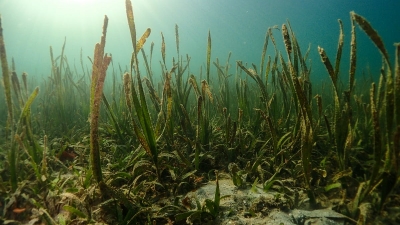
Where are they found?
Seagrasses are found is seas surrounding all continents except Antarctica. If you are lucky, you can spot them along the coast in clear, shallow waters. The water has to be clear so that sunlight can get through and help the photosynthesis. Some seagrass species grow in the space between the highest tide line and lowest tide line (inter-tidal zone). This is the area where you can see the seabed when the low tide retreats. Here seagrass grows close to mangrove belts and survives exposure to heat and dryness, thanks to the high humidity. Other species of sea grass (tape grass) are always found submerged in water in the sub-tidal zone. The eelgrass occurs in estuarine areas. When conditions are suitable, sea grass form dense underwater ‘meadows’-some of which are large enough to be seen from space.
Description
Sea grasses have roots, stems and leaves and produce flowers and fruits. They are closely related to land plants, and probably evolved from land living angiosperms (flowering plants) millions of years ago. The closest relatives to seagrass on land are grasses, palms and lilies.
How many seagrass species are known?
There are 72 different species of seagrasses in the world, belonging to four families. This is not much, but then “It is a huge challenge to evolve the capability to tolerate salt water and live in a submerged environment,” said Frederick Short a marine biologist from the University of New Hampshire and director of Seagrass Net, a global seagrass monitoring network.
The warm waters of the Indo-Pacific region have the highest number (14) of seagrass species in the world. This is because seagrass “evolved first in this part of the world, “Seagrass in this region have had a longer time to diversity and have had suitable growing conditions.
India being in the Indo-Pacific region, has 14 seagrass species. The Gulf of Mannar and Palk Strait house all the 14 species found in India, while the Lakshadweep and Andaman and Nicobar Islands have 8 and 9 species respectively.
How do they ‘breathe?
Land plants have small pores on their leaves called stomata, through which they can take in carbon dioxide from the air and release oxygen. Seagrasses do not have stomata. Instead, they have a thin cuticle layer which allows gases and nutrients to seep directly into the leaves from the surrounding water.
How do they reproduce?
The seagrass produces male and female flowers. The pinkish-green male seagrass flowers produce big pollen, up to 5mm long. Make flowers release pollen covered in a sticky, slimy substance into the surrounding water and the water-currents carry them over to the female flowers. Females have stigmas shaped like tentacles and are supported by coiled stalks. When male flowers release their pollen at night, the female flowers open their petals to ‘catch’ the drifting male flowers.
Their stalk straightens, and then coils and sinks down to the bottom.
Some seagrasses take the help of tiny marine invertebrates like amphipods (tiny shrimp-like creatures) and polychaetes (marine worms) for pollination. The seeds that result float and find suitable seabeds to grow new meadows.
In another method to sustain their species, seagrasses use their massive rhizomes-modified underground stems like ginger and turmeric. These rhizomes spread in the seabed and put out new roots and shoots. This way, a single plant can colonise a large area of seabed, and live on for thousands of years.
How are seagrasses helpful?
Dense seagrass growth traps flowing sediment and nutrients, and creates a world where life can thrive. Their leafy roof supports a wide grow on them: small marine invertebrates, which in turn attract sea anemones and fish; mega herbivores like green sea turtles and dugongs.
Picture Credit : Google
